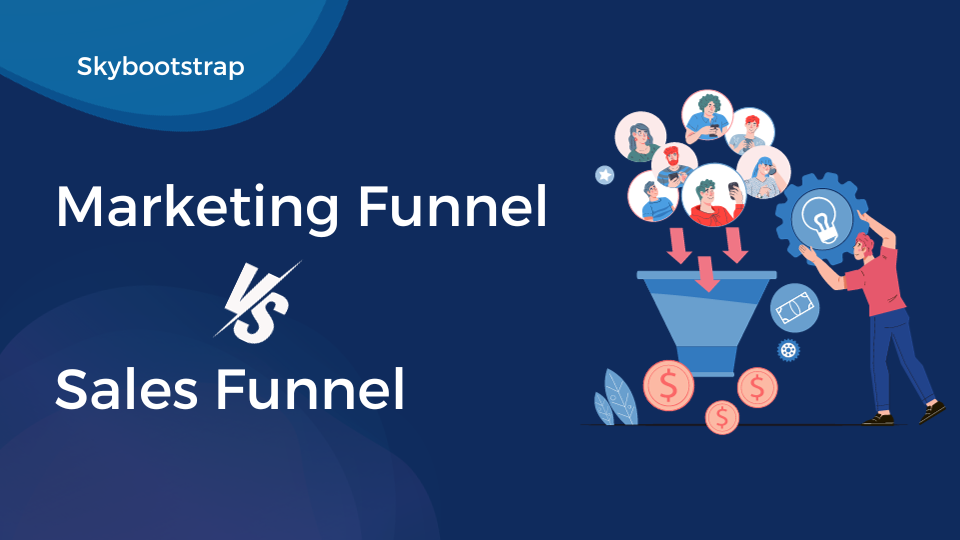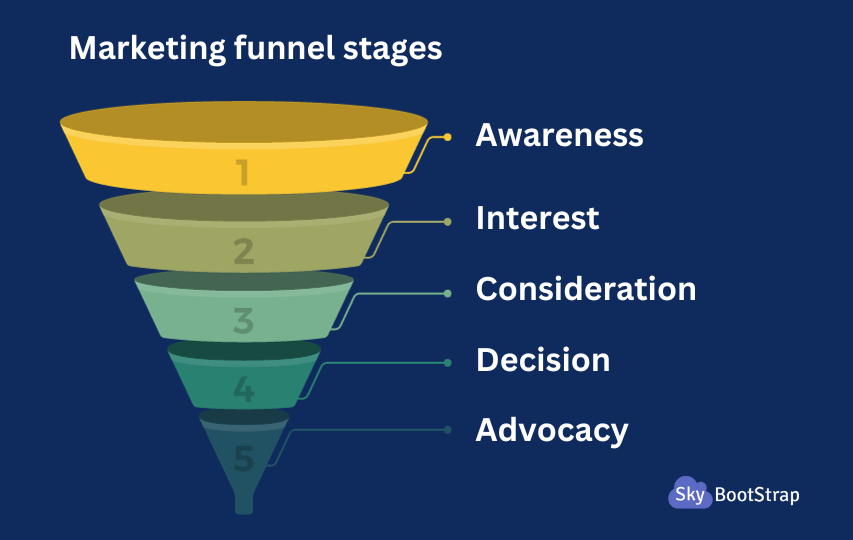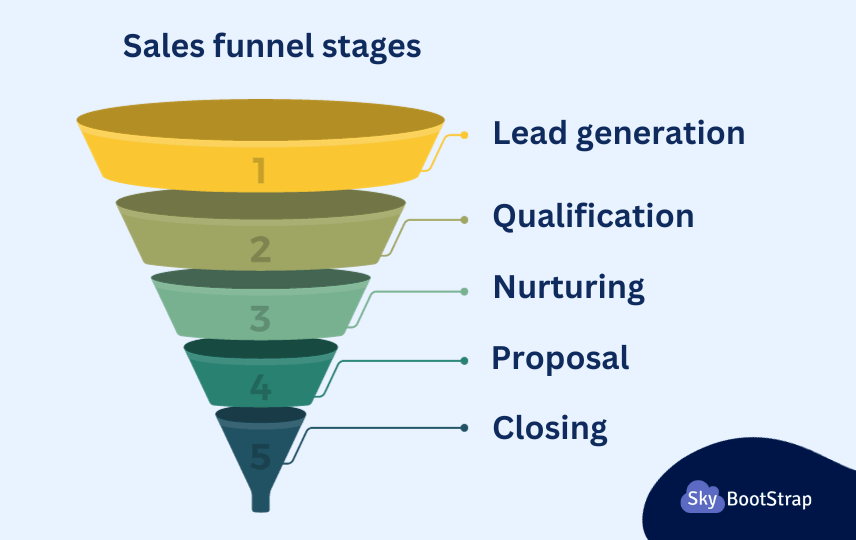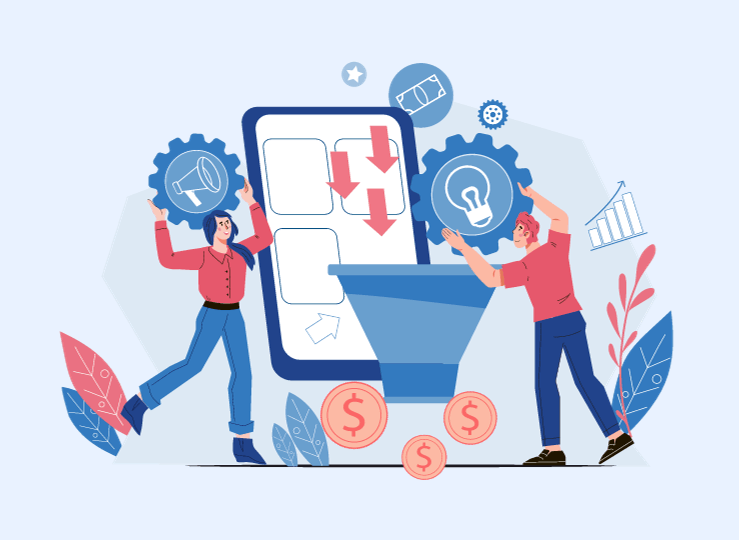
Marketing Funnel vs Sales Funnel: The Ultimate Guide of 2024
In today’s competitive business world, it is more important than ever for businesses to have a well-defined marketing and sales strategy. Marketing funnels and sales funnels are two essential tools that businesses can use to attract, nurture, and convert leads into customers.
A marketing funnel is a visual representation of the customer journey. It is a series of stages that potential customers go through before making a purchase. The goal of a marketing funnel is to attract, nurture, and convert leads into paying customers.
A sales funnel is a process that businesses use to convert leads into customers. It is a more focused version of the marketing funnel, and it typically begins when a lead has already expressed interest in the business’s product or service. The goal of a sales funnel is to close the deal and make the sale.

In this blog post, we will take a comprehensive look at marketing funnels and sales funnels in 2024. We will discuss the key differences between the two funnels, how they work together, and the benefits of using them. We will also provide tips for creating effective marketing and sales funnels.
Whether you are a small business owner or a marketing manager at a large corporation, this blog post will provide you with the knowledge and tools you need to create effective marketing and sales funnels that will help you to achieve your business goals.
What is a marketing funnel?
A marketing funnel, also known as a purchase funnel or sales funnel, is a visual representation of the customer journey. It is a series of stages that potential customers go through before making a purchase. The goal of a marketing funnel is to attract, nurture, and convert leads into paying customers.

What is a sales funnel?
A sales funnel is a process that businesses use to convert leads into customers. It is a more focused version of the marketing funnel, and it typically begins when a lead has already expressed interest in the business’s product or service. The goal of a sales funnel is to close the deal and make the sale.
The difference between marketing and sales funnels
The main difference between marketing and sales funnels is their focus. Marketing funnels are focused on generating leads and educating them about the business’s product or service. Sales funnels, on the other hand, are focused on converting leads into customers.
Another difference between marketing and sales funnels is their length. Marketing funnels are typically longer than sales funnels, as they involve more stages. Sales funnels, on the other hand, are typically shorter, as they focus on converting leads who are already interested in the business’s product or service.
Why are marketing and sales funnels important?
Marketing and sales funnels are important because they help businesses to understand and optimize their customer journey. By understanding the different stages of the funnel, businesses can create targeted marketing and sales campaigns that are more likely to convert leads into customers.
Marketing funnel stages
The marketing funnel is typically divided into five stages:

Awareness
This is the stage where potential customers become aware of the business’s product or service. This can happen through a variety of channels, such as advertising, social media, or word-of-mouth.
Interest
Once potential customers are aware of the business’s product or service, they may start to become more interested in learning more about it. This is where businesses can use content marketing, email marketing, and other tactics to educate leads and build relationships with them.
Consideration
This is the stage where leads are evaluating the business’s product or service against other options. They may be comparing prices, features, and benefits. Businesses can use this stage to nurture leads and answer any questions they may have.
Decision
This is the stage where leads are ready to make a purchase. They have evaluated all of their options and have decided that the business’s product or service is the best fit for their needs. Businesses can use this stage to make it easy for leads to buy their product or service.
Advocacy
Once a customer has purchased from a business, they may become advocates for the brand. They may recommend the product or service to their friends, family, and colleagues. Businesses can encourage advocacy by providing excellent customer service and by creating opportunities for customers to share their feedback.
Sales funnel stages
The sales funnel is typically divided into four stages:

Lead generation
This is the stage where businesses generate leads, which are potential customers who have expressed interest in the business’s product or service. This can be done through a variety of channels, such as online forms, landing pages, and trade shows.
Qualification
Once businesses have generated leads, they need to qualify them. This means determining which leads are most likely to become customers. Businesses can qualify leads by asking questions about their needs, budget, and timeline.
Nurturing
Once businesses have qualified leads, they need to nurture them. This means providing them with valuable information and building relationships with them. Businesses can nurture leads through content marketing, email marketing, and other tactics.
Proposal
Once leads are nurtured, businesses can send them a proposal. This is a document that outlines the business’s product or service, the benefits it offers, and the price.
Closing
Once businesses have sent a proposal, they need to close the deal. This means convincing the lead to purchase the product or service. Businesses can close the deal by following up with the lead, answering any questions they may have, and addressing any concerns they may have.
How marketing and sales funnels work together
Marketing and sales funnels work together to convert leads into customers. Marketing funnels generate leads and educate them about the business’s product or service. Sales funnels then convert these leads into customers.

It is important to note that the marketing and sales funnels are not linear. Leads can move back and forth between the different stages. For example, a lead may go from the interest stage to the consideration stage, and then back to the interest stage. This is why it is important for businesses to track their leads’ progress through the funnel so that they can provide them with the right information and support at each stage.
One way to track leads’ progress through the funnel is to use a CRM system. A CRM system allows businesses to store and track all of their lead data, including their contact information, their stage in the funnel, and their interactions with the business. This information can then be used to create targeted marketing and sales campaigns.
Examples of marketing and sales funnels in action
Here are a few examples of marketing and sales funnels in action:
E-commerce business
A potential customer visits an e-commerce website and browses the product catalog. They add a few items to their cart, but they don’t check out right away. The e-commerce business then sends them an email with a discount code to encourage them to complete their purchase. This is an example of a marketing and sales funnel working together to convert a lead into a customer.
Software company
A potential customer visits the website of a software company and downloads a free trial of their product. The software company then sends them a series of emails that educate them about the product’s features and benefits. The software company also offers them a free demo with a sales representative. This is an example of a marketing and sales funnel working together to nurture a lead and convert them into a customer.
Consulting firm
A potential client visits the website of a consulting firm and reads a blog post about the benefits of working with a consultant. They then sign up for a free consultation. The consultant then meets with the client to learn more about their needs and how they can help them. This is an example of a marketing and sales funnel working together to generate a lead and qualify them.

Benefits of using marketing and sales funnels
There are many benefits to using marketing and sales funnels, including:
Increase lead generation
Marketing and sales funnels can help businesses to increase lead generation by attracting more potential customers and converting them into leads.
Improve conversion rates
Marketing and sales funnels can help businesses to improve their conversion rates by nurturing leads and providing them with the information they need to make a purchase decision.
Boost sales
Marketing and sales funnels can help businesses to boost their sales by making it easy for leads to purchase their product or service.
Grow your business
Marketing and sales funnels can help businesses to grow their business by attracting new customers, converting leads into customers, and increasing sales.
Tips for creating effective marketing and sales funnels
Here are a few tips for creating effective marketing and sales funnels:
Define your target audience
The first step is to define your target audience. Who are you trying to reach with your marketing and sales funnels? Once you know your target audience, you can tailor your content and messaging accordingly.
Set clear goals for each funnel stage
For each stage of the funnel, you should set clear goals. For example, your goal for the awareness stage may be to increase website traffic. Your goal for the consideration stage may be to increase the number of leads who download your ebook. And your goal for the decision stage may be to increase the number of leads who sign up for a free trial.
Use the right marketing and sales tactics
There are a variety of marketing and sales tactics that you can use to attract, nurture, and convert leads. Some of the most common tactics include content marketing, email marketing, social media marketing, and paid advertising. You can take the help of tools such as CRM with email marketing to automate and simplify your work.
Track your results and make adjustments as needed
It is important to track your results and make adjustments to your marketing and sales funnels as needed. This will help you to identify what is working well and what is not.
Conclusion
Marketing and sales funnels are essential tools for businesses of all sizes. By understanding and using marketing and sales funnels effectively, businesses can increase lead generation, improve conversion rates, boost sales, and grow their business.
